10 Things To Know About The Samsung Galaxy S10
Samsung is releasing three models—the S10, S10+ and S10e—while also teasing a forthcoming 5G model.

Into A New Galaxy
It's a big year for Samsung's Galaxy S series—the 10th anniversary of the Samsung flagship, in fact. And as such, along with an array of new features and updates, Samsung is also increasing the number of models it's releasing. Instead of the usual two Galaxy S models, Samsung is introducing three new models—the standard Galaxy S10, larger-screened Galaxy S10+ and entry-level Galaxy S10e—while also teasing a fourth model, a 5G-capable Galaxy S10, that will debut at a later date. All of the models will include spec boosts along with new features around camera capabilities, wireless charging and biometrics.
What follows are 10 key things to know about the specs and features of Samsung's four new Galaxy S10 models.

Galaxy S10: General Specs
The Galaxy S10 model will feature a 6.1-inch display—making it larger than its counterpart from a year ago, the 5.8-inch Galaxy S9—with QHD+ (3,040 x 1,440) resolution. Other key specs for the Galaxy S10 include three rear cameras (up from two on the Galaxy S9) and a 3,400 mAh battery, an increase over the 3,000 mAh battery in the S9. The Galaxy S10 comes with 8 GB of RAM and choices between 128 GB and 512 GB of storage, up from maximum storage of 256 GB on the Galaxy S9. A MicroSD slot will allow for up to another 512 GB of storage in the S10, as well.
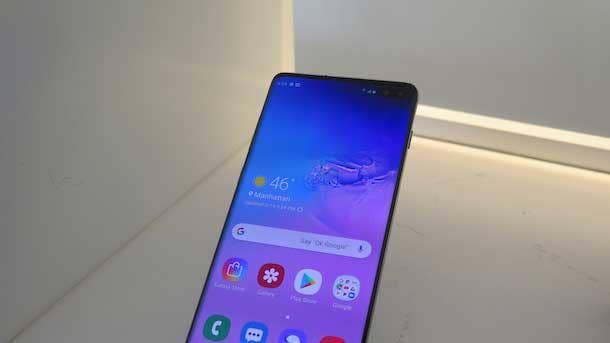
Galaxy S10+: General Specs
The Galaxy S10+ gets a bump on display size from its predecessor last year, with a 6.4-inch display compared with 6.2 inches on the Galaxy S9+. (That matches the size of last fall's Galaxy Note9.) The Galaxy S10+ shares the same screen resolution as the S10, at QHD+ (3,040 x 1,440), as well as the triple rear camera system. For the battery, the Galaxy S10+ moves up to 4,100 mAh from 3,500 mAh on the S9+ (and from 4,000 mAh on the Note9).
As for RAM and storage configurations, the Galaxy S10+ will be offered with 8 GB of RAM and 128 GB of storage; 8 GB of RAM and 512 GB storage; or 12 GB of RAM and 1 TB of storage. Users can add up to 512 GB of additional storage with a MicroSD card.
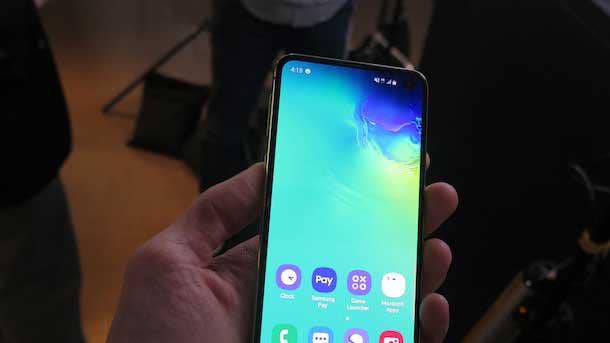
Galaxy S10e: General Specs
As the entry-level model in the new Galaxy lineup—and the model primed to compete most closely with Apple's iPhone XR—the Galaxy S10e offers a bit less on specs than the S10 and S10+ models. The Galaxy S10e comes with a 5.8-inch, FHD+ (2,160 x 1,080) display, a dual rear camera and a 3,100 mAh battery. The S10e comes in two variants for RAM and storage configuration—either with 6 GB of RAM and 128 GB of storage, or with 8 GB of RAM and 256 GB of storage. A MicroSD slot will enable up to 512 GB of extra storage in the S10e.
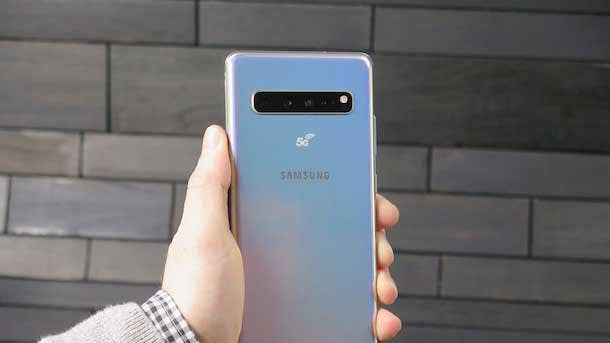
Galaxy S10 5G
While the 5G variant of the new Galaxy S10 won't come out until an unspecified later date, Samsung is revealing a few details about the phone and how it differs from the other three S10 models. First and foremost, the device will offer connectivity to 5G networks as they become available—which promises 20X faster speeds for everything from downloads, to data-intensive and computational-intensive applications, to videoconferencing. The Galaxy S10 5G model will also feature a larger display at 6.7 inches, making it the largest Galaxy smartphone display to date. In addition, the model include a bigger battery, at 4,500 mAh, and will include a different 3-D depth camera from the other models to help with enhanced augmented reality capabilities.

Display
All of the Galaxy S10 models will feature an AMOLED display, but one difference is that the S10e will include a fully flat screen while the S10 and S10+ will have curved edges. The Galaxy S10 models will all introduce a new design featuring a front-facing camera in the upper righthand corner, which has been described a "hole punch" camera design (which avoids the need for a camera notch as on the iPhone and numerous Android phones). The design also enables users to get even more of the phone as a usable display, with the screen making up 93.1 percent of the front of the phone, according to Samsung.
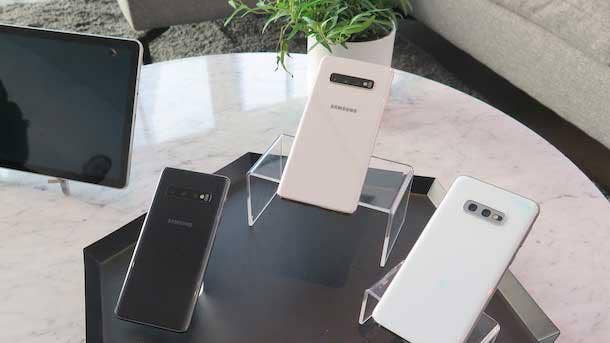
Camera
For the Galaxy S10, S10+ and S10e, Samsung is introducing a new camera sensor—an "ultra-wide" lens for capturing large scenes. The 16-megapixel ultra-wide camera features a 120-degree field of view, which is four times wider than the normal camera field-of-view, Samsung said. The S10e will include one other camera, a 12-megapixel wide-angle lens, while the S10 and S10+ will include two additional cameras—the 12-megapixel wide-angle lens and a 12-megapixel telephoto lens.
It's also worth mentioning that while all three models will feature a 12-megapixel front-facing camera, the S10+ will add a second front-facing camera—an 8-megapixel depth camera.
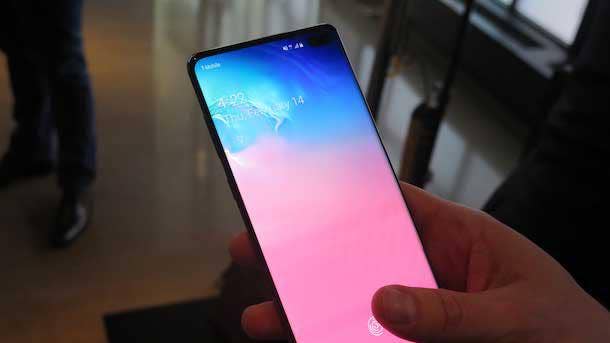
Biometrics
Along with continuing to offer facial recognition, Samsung is continuing to provide fingerprint scanning as a biometric authentication method in its Galaxy S smartphones. For the Galaxy S10, the scanner has gotten a revamp with the introduction of what Samsung is calling "ultrasonic" fingerprint scanning. The scanner offers a security boost with better anti-spoofing technology, where the scanner actually reads the 3-D ridges of a user's fingerprints, unlike other scanners that just take a 2-D picture. The ultrasonic scanner is also what has been called an in-display scanner, which is less obtrusive because it just appears on the unlock screen to show users where to place their finger, and then disappears afterward.
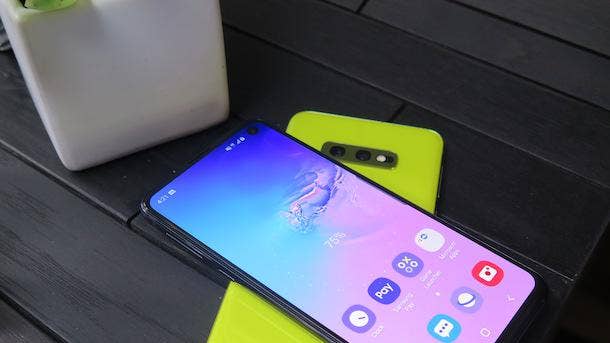
Charging
Another key new feature of the Samsung Galaxy S10 is the ability to wireless charge other Qi devices—even non-Samsung devices—by placing them on the back of the S10. The Wireless PowerShare feature essentially turns the S10 into a Qi wireless charging mat, allowing users to bring fewer charging cables with them (and potentially help out their friends with a charge of their depleted phone). Wireless PowerShare will be available for all of the new S10 models.

Performance
The Galaxy S10 models will move up to a powerful new Qualcomm chipset, the Snapdragon 855, an eight-core processor with a clock speed of up to 2.84GHz (compared with 2.8GHz on the Galaxy S9's processor, the Snapdragon 845). Along with the bump in processor performance, the Galaxy S10 also will support the latest Wi-Fi standard, known as Wi-Fi 6. With Wi-Fi 6, advantages include better speeds when connecting to access points in high-density environments. Ultimately, Wi-Fi 6 will be able to offer S10 users 20 percent faster speeds, according to Samsung.
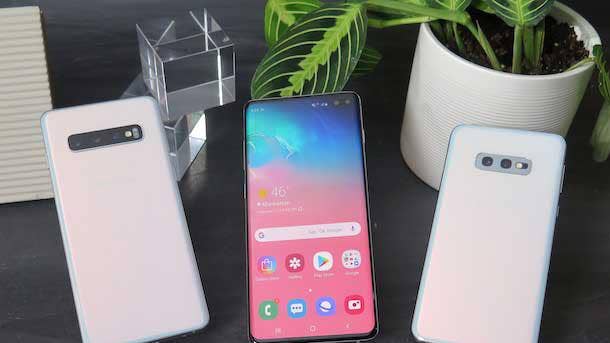
Price And Availability
Pricing for the Samsung Galaxy S10 starts at $899.99, while pricing starts at $999.99 for the Galaxy S10+ and at $749.99 for the Galaxy S10e. In terms of availability, pre-orders will launch for the Galaxy S10, S10+ and S10e on Feb. 21. The three phones will ship on March 8. Samsung did not disclose pricing for the Galaxy S10 5G, but said it will be available during the first half of 2019.